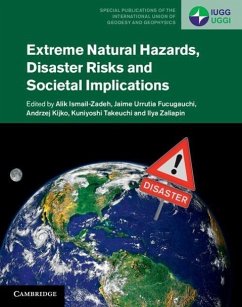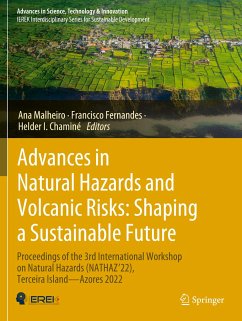
Natural Hazards and Risks within Disaster Management
Concepts, Applications, and Future Trends
Herausgegeben: Glade, Thomas; Marr, Philipp; Sternath, Sophia; Fröwis, Annika
Versandkostenfrei!
Erscheint vorauss. Mai 2026
38,99 €
inkl. MwSt.
How can we better understand, assess, and manage the risks posed by natural hazards in a rapidly changing world? This open access book provides clear answers by combining scientific knowledge with practical experience in disaster risk management. It equips readers with tools to identify and evaluate risks, introduces innovative approaches such as impact chains, and demonstrates how institutions and communities can strengthen their resilience.Covering a broad range of hazards from floods and storms to earthquakes and landslides the chapters present both established methods and emerging trends. ...
How can we better understand, assess, and manage the risks posed by natural hazards in a rapidly changing world? This open access book provides clear answers by combining scientific knowledge with practical experience in disaster risk management. It equips readers with tools to identify and evaluate risks, introduces innovative approaches such as impact chains, and demonstrates how institutions and communities can strengthen their resilience.
Covering a broad range of hazards from floods and storms to earthquakes and landslides the chapters present both established methods and emerging trends. Special attention is given to socio-economic and psycho-social dimensions, acknowledging that disasters impact people not only physically but also socially and emotionally. International and European frameworks, including the Sendai Framework and the EU Civil Protection Mechanism, are explored as models for effective, coordinated action.
By bridging research, policy, and practice, the book offers clear explanations, case examples, and forward-looking perspectives. Readers gain a structured understanding of evolving risks, their underlying drivers, and strategies for adaptation in the face of climate change, technological transformation, and growing vulnerabilities.
Designed as a concise yet comprehensive reference, this volume is an essential resource for students, researchers, practitioners, and policymakers seeking actionable insights and a future-oriented approach to disaster risk management.
Covering a broad range of hazards from floods and storms to earthquakes and landslides the chapters present both established methods and emerging trends. Special attention is given to socio-economic and psycho-social dimensions, acknowledging that disasters impact people not only physically but also socially and emotionally. International and European frameworks, including the Sendai Framework and the EU Civil Protection Mechanism, are explored as models for effective, coordinated action.
By bridging research, policy, and practice, the book offers clear explanations, case examples, and forward-looking perspectives. Readers gain a structured understanding of evolving risks, their underlying drivers, and strategies for adaptation in the face of climate change, technological transformation, and growing vulnerabilities.
Designed as a concise yet comprehensive reference, this volume is an essential resource for students, researchers, practitioners, and policymakers seeking actionable insights and a future-oriented approach to disaster risk management.













